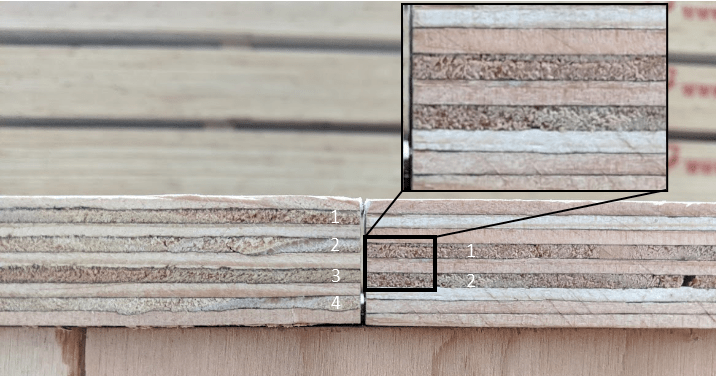Where does the name F10/F16 come from?
Mass Ply Panel grades are named after the company that created Mass Ply, Freres (F) Lumber Company. F16 and F10-rated panels are considered structural wood products just like any glulam beam or structurally rated plywood. A structural rating means Mass Ply has undergone numerous stress tests, quality control checks, and engineered design checks to ensure a consistent, high-performing product. Each product is certified by the same process and overseen by the APA (the Engineered Wood Association).

Figure 1: F16 vs F10 Lay-up Comparison of Mass Ply. Looking from the long edge, can see the “rough looking wood” or “end grain” of our crossband layers or “veneer”. The left panel (F10) has 9 layers total with 4 crossbands while the right panel (F16) also has 9 layers but with only 2 crossbands.
What do F16 and F10 grades mean?
Mass Ply Panel grades come with a lot of information about the product. For Mass Ply, the higher your grade number, the stiffer the material is rated in its major force direction. For example, if you drove a truck over an F16 panel, then again over an F10 panel, you could count on your F16 panel bending less than your F10 panel. Part of the reason an F16 bends less than an F10 is from the layup or stacking order of the layers in a panel (Figure 1). The more crossbands you put into your panel, the more flexible your panel becomes in the major force direction.
Where should I use an F16 panel? F10?
Just because an F10 is more flexible in the major force direction doesn’t mean we should discount it. Think about your grades of Mass Ply like cars. An F16 panel is like the sports car of your project while the F10 acts like the pickup truck. While a pickup truck can’t always move as fast as the sports car, it has much more versatility. While F16 panels specialize in the major force direction, an F10 panel specializes in the minor force direction and being versatile. Here are a few common uses of each panel:
| F16 Panels | F10 Panels |
|---|---|
| • Floor panels with supports perpendicular to the outside wood grain or “major force bending” | • Floor panels with supports parallel to the outside wood grain or “minor force bending” |
| • Beams and columns of a structure | • Floors with a large overhang or “cantilever” |
| • Structural walls | • Structural walls |
A more versatile panel allows designers to play with building layout and get creative with loads. With the introduction of an F10 grade designers can now optimize their design and take advantage of all aspects of the Mass Ply panel.
Subscribe
We’ll send you a notification when a new story has been posted. It’s the easiest way to stay in the know.